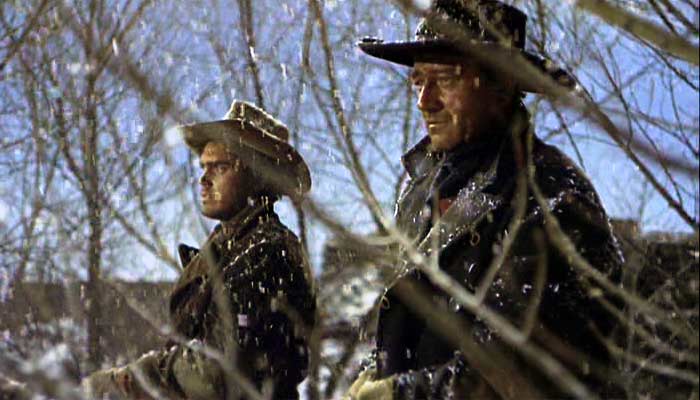A great sense of atmosphere is created when watching a Western and none more so than The Searchers, an epic collaboration between director John Ford and Western icon John Wayne. It may be over 50 years old, but there is still a sense of grand and sweeping melodrama in its theatrical settings. This theatricality is extended to the physical performance of the actors, seen in the staged fight choreography and the fluttering hand of a woman as she gazes into the panoramic vistas of the American West.
But for all its physical melodrama, the actors portray their emotions with heartfelt sincerity. John Ford’s hand is deftly at work during the scenes where he is allowed to leave the studio and revel in the glory and freedom of location shoots. He interchanges his vast establishing shots with tightly crafted, geometric cinematography, dramatically framing his characters and creating memorable silhouettes, while heightening tension with fighting lines of cowboys and Indians.
The very notion and term “cowboys and Indians” feels simultaneously nostalgic and archaic, the latter in great part due to its rampant racism which is keenly felt when watching it today (and even more so when you watch the behind-the-scenes footage, which is so nauseatingly ignorant you can’t help laughing). Rampant racism aside the story of the heroes, at least, is well-constructed, given depth in the beginning of the film with the hinted anxiety of the post-war era, as well as family tension.
However, despite interesting characters and a fantastic tumultuous relationship that develops between John Wayne and Jeffrey Hunter’s characters Ethan Edwards and Martin Pawley, the end unravels at the seams. The film is interlaced with comedy and sweet romance to lighten the often grim and violent pathos of the story, but the comedic bouts at the end ask too much of the audience’s imagination. And even though Ethan is painted as a man both enigmatic and unpredictable, his actions at the end of the film are the product of a Hollywood dream-machine, instead of good character development. What could have been an interesting confrontation becomes a quick and easy resolution.
There is much to fault: like the rickety sets, blatant studio lighting and temporal stereotypes – hammered home by the despairingly funny washing powder commercial in the behind-the-scenes footage; and much to praise, from its tone-setting score and gorgeous rendering of the seasons to Vera Miles’ feisty performance and John Wayne’s broody anti-hero. The key is to enjoy the good through the rose-tinted glasses of the ‘50s and the feeble apology, “product of its time”; while remaining aware of maligned antagonists and John Wayne’s politics.
Originally published on Amazing Picture Box
Image source
